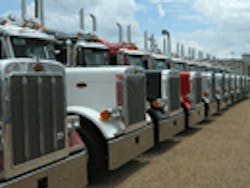Net orders for heavy-duty Class 8 commercial vehicles fell to 6,513 units in January, down 18% from January 2009, with medium-duty Class 5-7 net orders down 6% in the same month-to-month comparison, according to ACT Research Co. (ACT).
“This doesn’t shock me,” Kenny Vieth, partner and senior analyst with ACT, told Fleet Owner. “We still have a supply-demand imbalance when it comes to freight volumes and truck capacity; basically, we still have too many trucks and not enough freight.”
Though the economy is showing signs of improvement, which could correct that freight-truck capacity imbalance, Vieth noted that the steep increase on new truck prices due to the addition of costly technology to limit exhaust emissions is further dampening demand for new iron.
Indeed, ACT said actual North American Class 8 production came in ahead of expectations and just 3% below January 2009 as a stronger volume of orders late last year get pushed into the production line this year – orders fleets made to avoid the 2010 emissions-related price increase on Jan. 1.
“Buyers are looking at a $9,000 to $10,000 increase in just the base price of a new truck,” said Vieth. “That’s before the taxes are figured in. On a truck costing $9,000 more, with the 15% FET [Federal Excise Tax] and 6% to 7% local and state taxes added in, that price increase jumps to over $11,000.”
Another factor complicating this situation, he said, is that used truck prices still remain relatively low – meaning residual values remain depressed, not giving owners much incentive to trade in older equipment.
Truckers also need to make more money in order to afford new equipment, said Vieth, but that’s a tall order given what the trucking industry has been though. According to Fitch Ratings, the trucking sector has been in a ‘freight recession’ since mid-2006, with demand declines accelerating heavily last year. Although truck volumes generally appear to be on an upward trajectory now, Fitch expects industry revenue will remain under pressure well into 2010 – with volumes growing only mildly as the year progresses.
In particular, although inventories are expected to grow with the strengthening U.S. economy, Fitch believes continued consumer deleveraging and persistent high unemployment will restrain the rate of demand growth, particularly for volumes tied to retail goods, which are a key driver of truck volumes.
“While supply-demand imbalance in the U.S. freight market continues to improve, we are still a quarter or two away from material improvement in freight rates,” added Vieth.
About the Author
Sean Kilcarr
Editor in Chief
Sean Kilcarr is a former longtime FleetOwner senior editor who wrote for the publication from 2000 to 2018. He served as editor-in-chief from 2017 to 2018.
